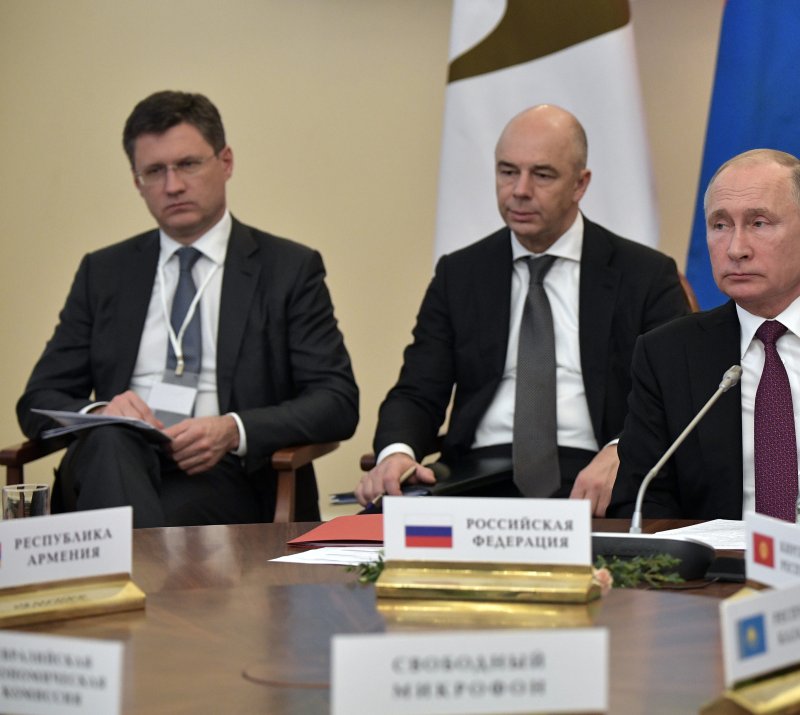Russian President Vladimir Putin (R), Finance Minister Anton Siluanov (C) and Energy Minister Alexander Novak (L) attend a meeting of the Eurasian Economic Union in St.Petersburg, Russia, to discuss issues including energy on Dec. 6, the same day OPEC countries met in Vienna. Photo by Alexey Nikolsky/EPA-EFE/Kremlin pool mandatory credit
Jan. 18 (UPI) -- The Paris-based International Energy Agency on Friday cast doubt on whether Russia would meet its agreement with OPEC to cut crude oil output to support prices, while Russia's Energy Minister Alexander Novak said it is impossible for his country to quickly cut production.
"Data show that Russia increased crude oil production in December to a new record near 11.5 million barrels per day and it is unclear when it will cut and by how much," the report said.
"While Saudi Arabia is determined to protect its price aspirations by delivering substantial production cuts, there is less clarity with regard to its Russian partner," the report added.
OPEC, led by Saudi Arabia, agreed on Dec. 7, along with non-OPEC partners, to reduce production by 800,000 barrels per day. Non-OPEC countries, led by Russia, committed to cut 400,000 barrels per day of production. The result, after long negotiations, was a compromise of 1.2 million barrels per day output reduction from October levels, starting January 1.
"When we discussed this issue in December at the signing of agreements, we frankly said that the achievement of these indicators would take some time," Novak said Thursday, as reported by Sputnik news agency.
"We have special conditions. We have a winter period, we have low temperatures, we have special climatic and geological conditions of production. Therefore, in principle, it's impossible to quickly reduce production," he said.
"Naturally, we will try to make reductions as fast as possible. Russia is committed to these agreements," the minister added.
Back in October, asked about whether Russia would consider joining OPEC officially, Novak had said that Russia would not do it because it would imply "legal obligations."
In December 2016, an accord between the OPEC and non-OPEC countries resulted in production cuts that helped support crude oil price levels.
The agreement involving Russia and Saudi Arabia, at the time the world's two biggest crude oil producers, was fundamental to the achievement of production cuts and the support of price levels.
Brent prices, which traded under $50 per barrel in late November 2016, rose to over $55 in early January 2017. Then in June of that year they started a steady climb that reached a peak of $86 per barrel in early October of last year.
However, the possibility of accords not just between OPEC and Russia, but also within OPEC, appears to have hit difficulties in their December meeting, as Russia's role in the organization's discussions gained predominance.
A big change since the 2016 agreement was the surge of production by the United States, which in the second half of last year became the world's biggest producer of crude oil, thanks to development of unconventional oil fields. This turned Russia and Saudi Arabia into the second and third biggest producers.
In the United States, "we saw incredible and unexpected growth in total liquids production of 2.1 million barrels per year in 2018. For this year, we have left unchanged for now our forecast for growth of 1.3 million barrels per day," the IEA said.
"While the other two giants voluntarily cut output, the U.S., already the biggest liquids supplier, will reinforce its leadership as the world's number one crude producer. By the middle of the year, U.S. crude output will probably be more than the capacity of either Saudi Arabia or Russia."
World oil demand, meantime, faces a mixed picture, with lower prices meeting "weakening confidence" about the global economy.
"For now, we retain our view that demand growth in 2018 was 1.3 million barrels per day, and this year it will be slightly higher at 1.4 million barrels per day, mainly due to average prices being below year-ago levels," the IEA said.
The IEA was set up after the 1973-1974 Middle East War in an attempt by the Organization for Economic Cooperation and Development to have an organization to manage oil related information that could rival efforts by oil producer nations, which had formed OPEC, in gathering energy information.
The OECD was created in the 1960s initially by the United States, Canada and 18 European countries. It now includes 34 countries.















